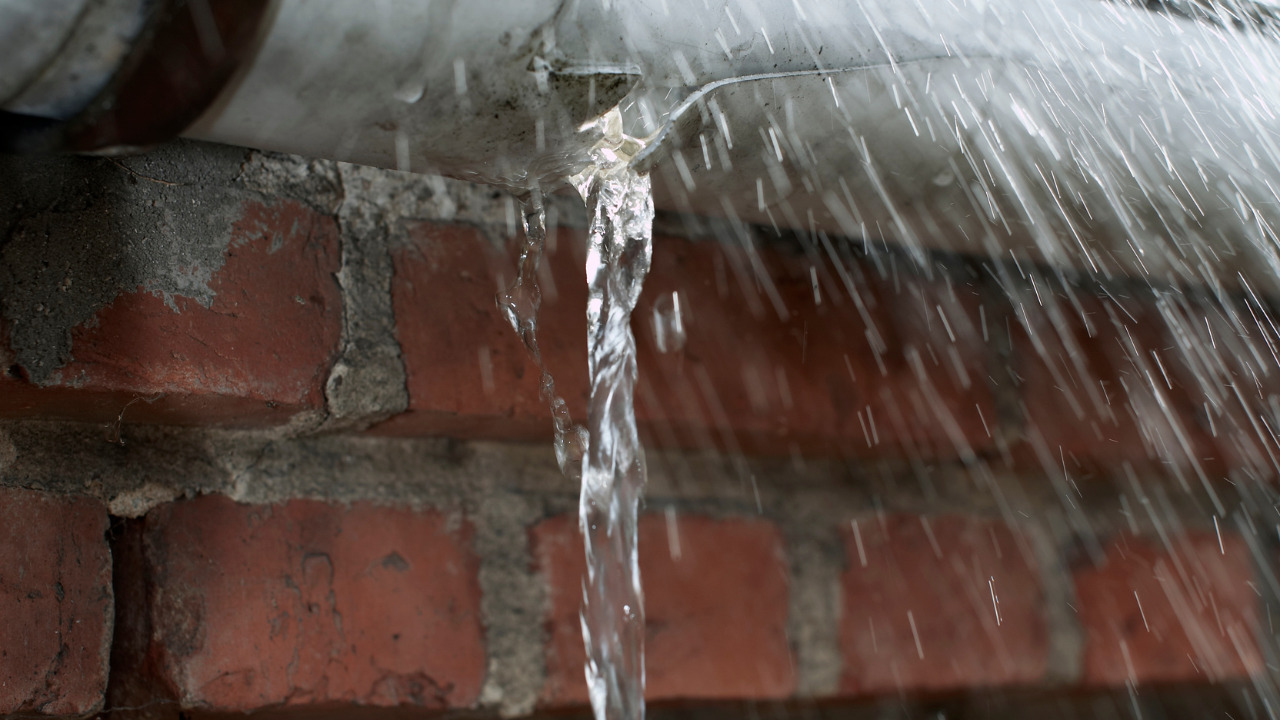Imagine your newly installed drop ceiling has water dripping. You get to worry about where’s the leakage, or how far is the damage. It’s not just inconvenient to have a ceiling leak. If you don’t get it fixed as quickly as possible, it could cause severe damage to your entire property. It takes time and skill to fix a ceiling leak all the way through.
The method of repairing a ceiling leak isn’t as complicated as it appears. Slow ceiling leaks can lead to mold growth and yellowish-brown discoloration. Large leaks and busted pipes will destroy the ceiling.
This tutorial will explain everything you need to know when water leaks from your ceiling to the reasons on how to fix ceiling leaks.
Table of Contents
4 Most Common Reasons for Leaking Sealing
Plumbing or roof leaks are the most common causes of water leaks from the ceiling. Slow leaks that generate yellowish-brown water spots are the most common source of ceiling water damage. On the other hand, a significant leak can cause water to flow through your ceiling in minutes.
Roof Leakage
Most roof leaks are caused by damaged or missing shingles, which allow rain or snow to enter your home. While you would think that these leaks only happen in the spring and summer, they happen all year round.
Ice dams grow under your shingles due to repeated freezing and thawing, allowing water to enter through your roof. Roof damage is the cause of a water-damaged ceiling below your attic or along the eaves of your home.
Roof leaks frequently result in more prominent water stains on your ceiling, which soon turn brown and moldy if not addressed. The spot may grow larger with each rainstorm, and water may run down your walls. You may need to climb up to fix roof damage but first inspect the situation more thoroughly and determine what’s causing the leak.
Plumbing Issues
Plumbing issues are the most common source of ceiling leaks. When the caulk in the bathroom wears away, water can seep into the walls and drip down to the ceiling. In addition, pipes might sweat in both the summer and the winter.
Pipes and plumbing connections may leak with time, though this is unlikely. Pipes can rupture, or appliances can leak in rare situations. If the ceiling water damage is right below a bathroom or kitchen, it could result from a plumbing leak.
But you need to check the basements as well. Plumbing issues can cause basements to flood too, on bad rainy days. Basements with low ceilings can be compromised if the finishing isn’t adequate. Combined with the plumbing issue – you have a disaster on hand.
Roof Fascia Issue
As the roof is damaged, the roof fascia will become more prone to harm as well. Any possible blockage can become the cause of a leak in the ceiling as well. Therefore it will require repairing or you need to install a new one.
Usually, roof fascia is made out of wood, aluminum, or PVC. In case it is clogged or there’s leakage in pipes, water can seep into the roof interior making a noticeable water drip. Lack of proper cleaning of roof fascia is yet another reason behind the leaking ceiling that sometimes homeowners have to face.
Especially if you live in a highly humid area, moisture can easily damage the fascia materials and make the boards unstable. With time, the materials can wear and tear causing cracks, hence yet another reason for leakage.
Blocked Gutter System
Roofing with gutters and leaders is important to avoid leaks in the ceiling. If you are facing this issue, then it can be due to a blocked gutter system.
However, a collapsed gutter leader can cause blockage or a lack of cleaning. Homeowners need to consider gutters and leader cleaning to ensure no debris sits still inside the pipes over the long haul.
How to Identify the Leak in the Ceiling
To better be sure about where’s the leak and its severity, you can try the following steps.
Identify the Leak Source
Before you can fix the leak in the ceiling, you need to mark the location of the leak. For this purpose, the best way is to take a bucket and a painter’s tape. Whether you have a painted cathedral ceiling or a flat one, this method is equally efficient for either type of ceiling.
Dampen the Area
To make the leakage more prominent, and to see a pattern, you need to place the bucket on the area you suspect is the leaking source. Use the water to dampen the suspected area to easily identify the leakage point.
Tape the Leaking Area
Using a strip of painter’s tape, you can tape the suspected leak. If it’s possible, it is recommended to tape directly over the dripping zone. Also, take notes in case of other suspected leaks. It will make it easier to spot any other leaking in the ceiling. This way you can inspect and almost identify the root cause of the leak.
Do a Water Test
Once the ceiling is damp with the water you used, wait at least 5 minutes to let the water soak through the paint. But before doing this, remove any debris or dust from the ceiling. Once the water absorbs into the paint and to the ceiling, the dripping point becomes more visible.
Check Outdoor Leaks
Do you have a faucet outdoors? If so, you better check it and fix leaky outdoor faucet. To inspect it use a pressure washer on the suspected area of the roof. Use your painter’s tape to mark the suspected zone.
Spray the roof area over the top of the applied tape. If a drip appears, you have a possible plumbing issue with the outdoor faucet installed.
Ways to Repair Ceiling Leakage
Fortunately, most indicators of ceiling leaks are visible. If you see any of the indicators listed above you can repair ceiling leakage in the following ways.
1. Clean Water Immediately
The damp ceiling must then be dried as rapidly as possible. This will help prevent mold and limit the damage. While conventional house fans will dry your ceiling, it may take days or even weeks.
Instead, for the fastest drying period, use high-volume fans and a structural drying dehumidifier. Most equipment rental firms have these available.
Make sure the fans are aimed at the ceiling and, if possible, increase them. Place the dehumidifier under the damp ceiling and empty it regularly. Make sure the ceiling and the wood joists on the interior are completely dry. Use the bucket so that you can avoid the water from spreading on the floors. Move the furniture out of the way in case the leak is in the living room.
2. Control Water Flow
If the leak in the ceiling is due to a plumbing issue, you need to remove fixtures in that area. You can drain the water from the lines by turning off the main water line and opening the lowest faucet in your house until the water problem is resolved.
In case the leak is due to a gutter system, you are likely facing a roofing issue. It will be harder to control the water flow because leaks can occur from multiple spots. You can use a screwdriver to create a hole in the ceiling to allow water to flow out rather than pool on the exterior of the ceiling. After this, you can install new rain gutters to prevent any further leaks.
3. Repair the Toilet at Base
The toilet leaking at the base should be repaired if it is an internal ceiling leak. There may be ridges of water around the base of the toilet, which can be an indication of a problem.
To take care of the issue, follow these steps.
- Remove the toilet altogether.
- Then scrape off the wax ring seal and check the closet flange. In case it’s broken or rusted, replace it.
- You need to install a new wax seal (or maybe a silicone seal) at the bottom to replace the toilet.
- Do not forget to caulk around the toilet base.
4. Replace the Sink Drain Pipes
In case it’s a kitchen sink leak you need to take the following measures.
- Check the supply line to fix under kitchen sink leak, and replace it in case of a leak.
- Check under the kitchen sink and tighten or replace the supply lines that are leaking.
- Run the water to check the P-trap. If it is still leaking, re-install or replace it.
- For a leak behind the drywall, cut the damaged line and push-fit connectors.
5. Seal The Repaired Areas
After the mud or plaster has dried, apply a sealing primer to the damaged area. Not only will this prevent water stains and seams, but it will also keep the ceiling from absorbing paint. It will take many more coats of paint if you don’t use priming.
Before applying your topcoat, apply at least two coats of primer. You can feather the topcoat into the old paint for tiny parts. For more significant areas of the ceiling, painting the entire ceiling is easier.
6. Replace leaking Gutters
You need to clean gutters on a regular basis. After cleaning always check for the water flow. If the issue is persistent, measure the gutter’s slope so that minor sags can be repaired. In case of severe issues, remove and install a new gutter system.
Also, do not forget to add the gutter guards. Their benefits are undeniable, especially in the case of a leak in the ceiling.
7. Repair The Ceiling by Hiring a Professional
Depending on the severity of the leak and the ceiling type, this could be as simple as a touch-up with Spackle and paint, or it could necessitate replacing and repainting the entire ceiling. Remember that it’s frequently easier just to remove damaged drywall and replace it with dry material.
This frequently exposes ceiling joists, making it easier to hang patches. It’s the same with painting; in the case of a significant leak, it’s generally easier to feather new paint into a broader area or even paint the entire ceiling.
No More Leaks!
A ceiling leak is a severe problem that should not be ignored. Even if the only issue you notice is a water stain, this indicates a significant problem. In fact, by the time water damage becomes apparent, the problem has already gotten out of hand. This is why a thorough roof inspection should be performed every year or two.
Also, opt for quarterly or annual roof repairs alongside cleaning gutters and leaders. Regular home maintenance is a miracle that you can gladly implement to say goodbye to leaks.





